flat tire TOYOTA C-HR 2020 Warranties & Maintenance Guides (in English)
[x] Cancel search | Manufacturer: TOYOTA, Model Year: 2020, Model line: C-HR, Model: TOYOTA C-HR 2020Pages: 260, PDF Size: 8.54 MB
Page 39 of 260
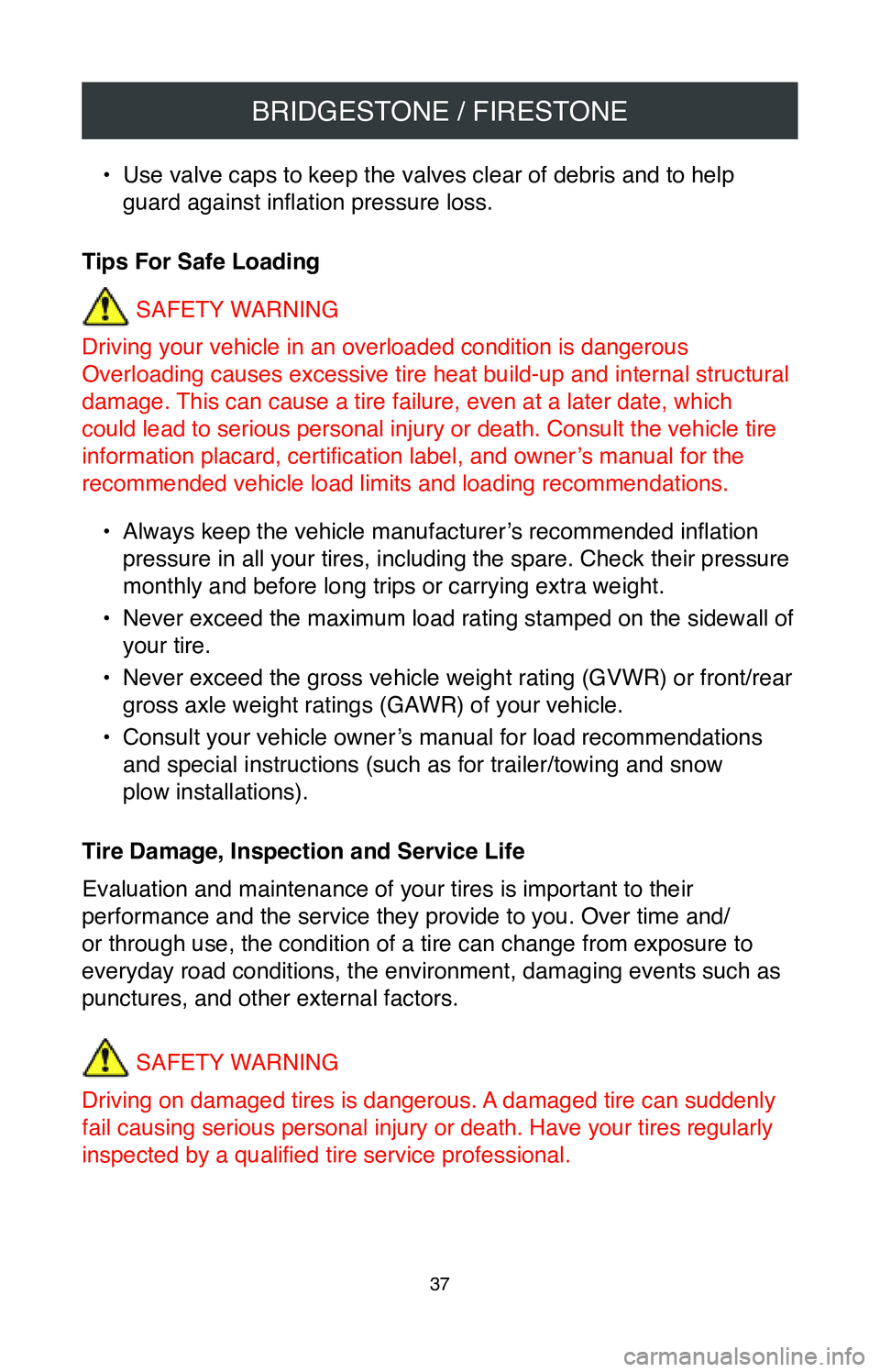
BRIDGESTONE / FIRESTONE
37
• Use valve caps to keep the valves clear of debris and to help
guard against inflation pressure loss.
Tips For Safe Loading SAFETY WARNING
Driving your vehicle in an overloaded condition is dangerous
Overloading causes excessive tire heat build-up and internal structural
damage. This can cause a tire failure, even at a later date, which
could lead to serious personal injury or death. Consult the vehicle tire
information placard, certification label, and owner’s manual for the
recommended vehicle load limits and loading recommendations.
•
Always keep the vehicle manufacturer’s recommended inflation
pressure in all your tires, including the spare. Check their pressure
monthly and before long trips or carrying extra weight.
•
Never exceed the maximum load rating stamped on the sidewall of
your tire.
•
Never exceed the gross vehicle weight rating (GVWR) or front/rear
gross axle weight ratings (GAWR) of your vehicle.
•
Consult your vehicle owner’s manual for load recommendations
and special instructions (such as for trailer/towing and snow
plow installations).
Tire Damage, Inspection and Service Life
Evaluation and maintenance of your tires is important to their
performance and the service they provide to you. Over time and/
or through use, the condition of a tire can change from exposure to
everyday road conditions, the environment, damaging events such as
punctures, and other external factors.
SAFETY WARNING
Driving on damaged tires is dangerous. A damaged tire can suddenly
fail causing serious
personal injury or death. Have your tires regularly
inspected by a qualified tire service professional.
Page 40 of 260
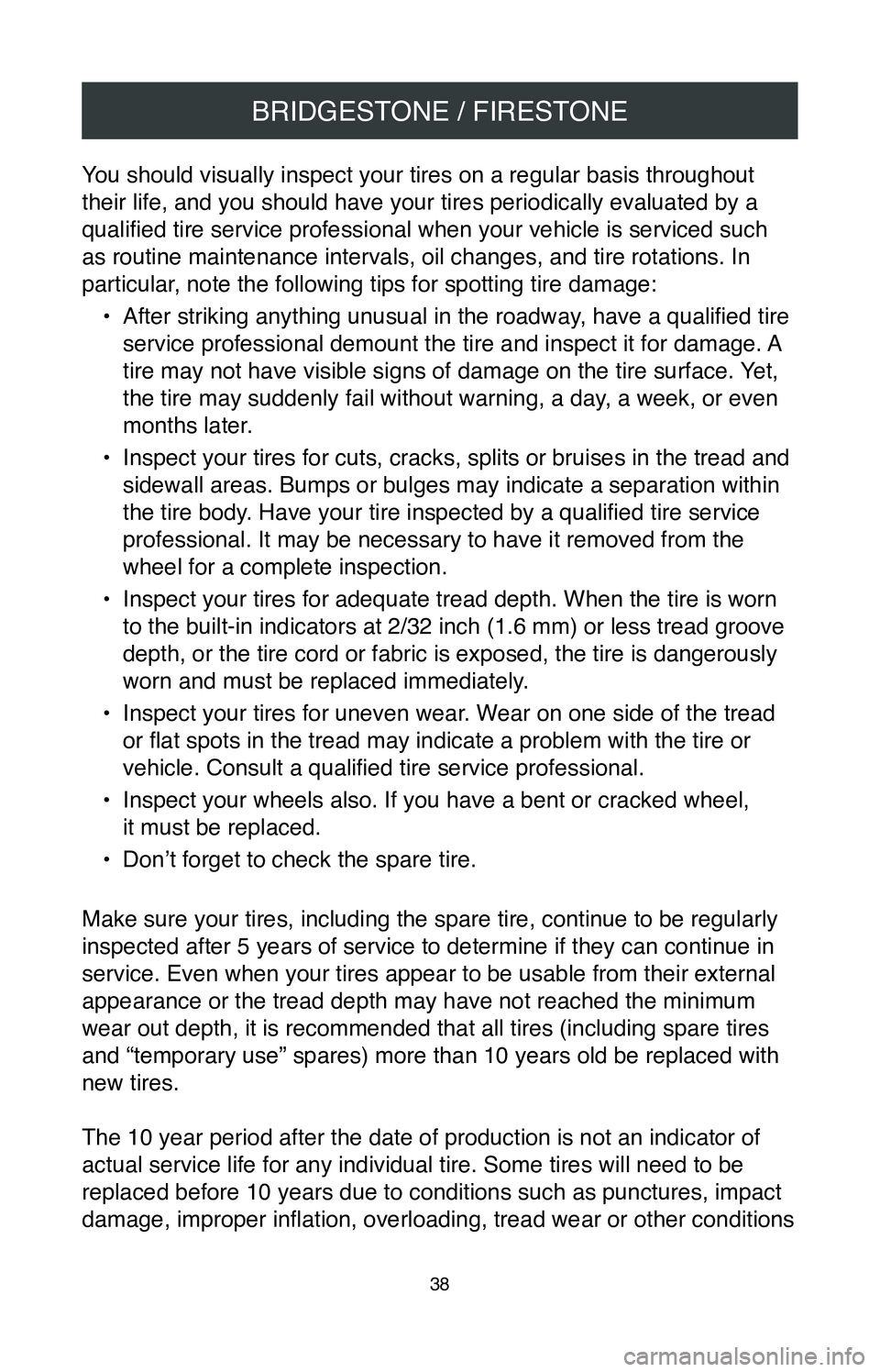
BRIDGESTONE / FIRESTONE
38
You should visually inspect your tires on a regular basis throughout
their life, and you should have your tires periodically evaluated by a
qualified tire service professional when your vehicle is serviced such
as routine maintenance intervals, oil changes, and tire rotations. In
particular, note the following tips for spotting tire damage:•
After striking anything unusual in the roadway, have a qualified tire
service professional demount the tire and inspect it for damage. A
tire may not have visible signs of damage on the tire surface. Yet,
the tire may suddenly fail without warning, a day, a week, or even
months later.
•
Inspect your tires for cuts, cracks, splits or bruises in the tread and \
sidewall areas. Bumps or bulges may indicate a separation within
the tire body. Have your tire inspected by a qualified tire service
professional. It may be necessary to have it removed from the
wheel for a complete inspection.
•
Inspect your tires for adequate tread depth. When the tire is worn
to the built-in indicators at 2/32 inch (1.6 mm) or less tread groove
depth, or the tire cord or fabric is exposed, the tire is dangerously
worn and must be replaced immediately.
•
Inspect your tires for uneven wear. Wear on one side of the tread
or flat spots in the tread may indicate a problem with the tire or
vehicle. Consult a qualified tire service professional.
•
Inspect your wheels also. If you have a bent or cracked wheel,
it must be replaced.
•
Don’t forget to check the spare tire.
Make sure your tires, including the spare tire, continue to be regularly\
inspected after 5 years of service to determine if they can continue in \
service. Even when your tires appear to be usable from their external
appearance or the tread depth may have not reached the minimum
wear out depth, it is recommended that all tires (including spare tires
and “temporary use” spares) more than 10 years old be replaced wi\
th
new tires.
The 10 year period after the date of production is not an indicator of
actual service life for any individual tire. Some tires will need to be \
replaced before 10 years due to conditions such as punctures, impact
damage, improper inflation, overloading, tread wear or other conditions
Page 42 of 260
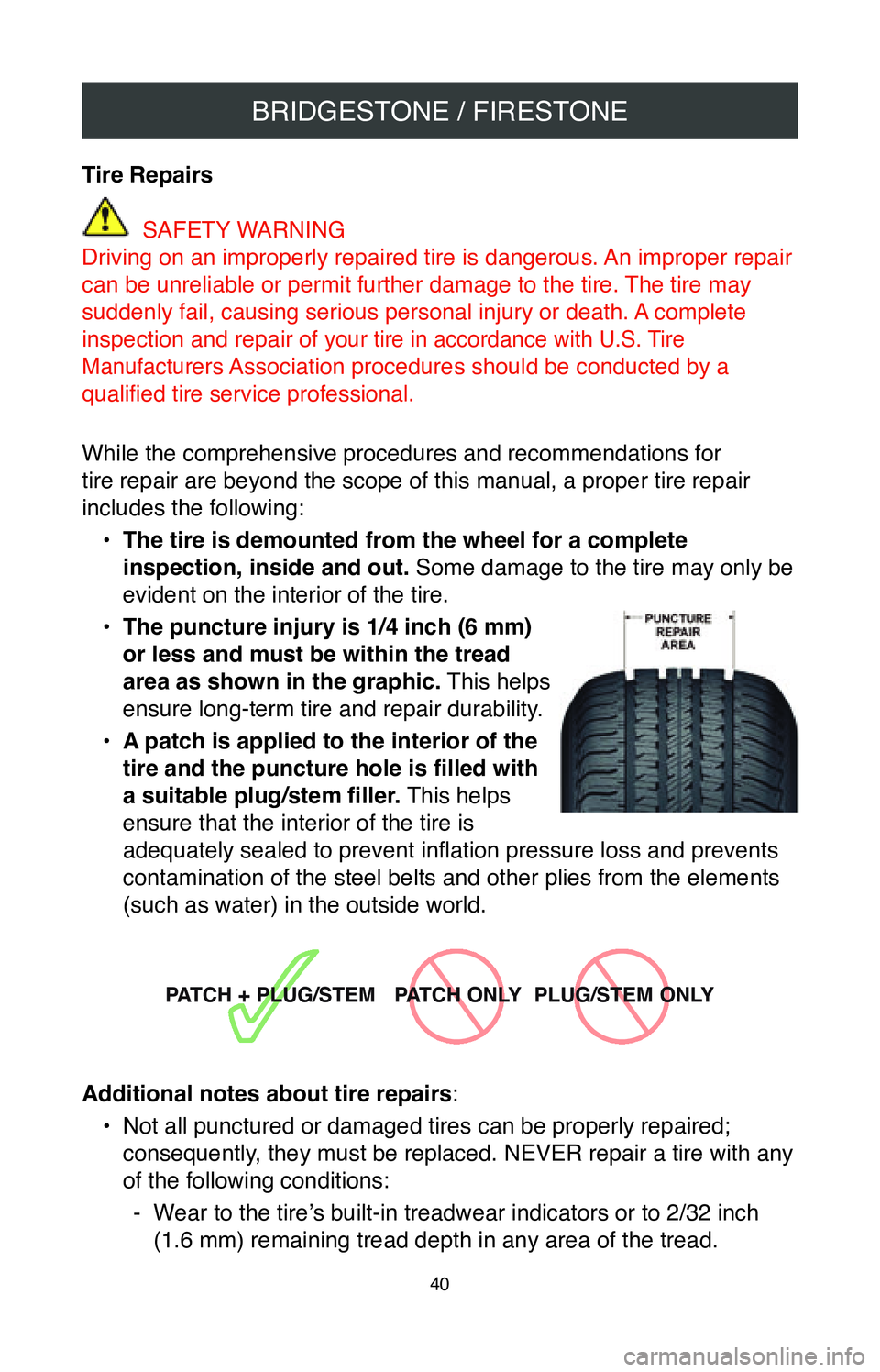
BRIDGESTONE / FIRESTONE
40
Tire Repairs
SAFETY WARNING
Driving on an improperly repaired tire is dangerous. An improper repair
can be unreliable or permit further damage to the tire. The tire may
suddenly fail, causing serious personal injury or death. A complete
inspection and repair of
your tire in accordance with U.S. Tire
Manufactur
ers Association procedures should be conducted by a
qualified tire service professional.
While the comprehensive procedures and recommendations for
tire repair are beyond the scope of this manual, a proper tire repair
includes the following:
•
The tire is demounted from the wheel for a complete
inspection, inside and out. Some damage to the tire may only be
evident on the interior of the tire.
•
The puncture injury is 1/4 inch (6 mm)
or less and must be within the tread
area as shown in the graphic. This helps
ensure long-term tire and repair durability.
•
A patch is applied to the interior of the
tire and the puncture hole is filled with
a suitable plug/stem filler. This helps
ensure that the interior of the tire is
adequately sealed to prevent inflation pressure loss and prevents
contamination of the steel belts and other plies from the elements
(such as water) in the outside world.
PATCH + PLUG/STEM PATCH ONLY PLUG/STEM ONLY
Additional notes about tire repairs :
•
Not all punctured or damaged tires can be properly repaired;
consequently, they must be replaced. NEVER repair a tire with any
of the following conditions:
- Wear to the tire’s built-in treadwear indicators or to 2/32 inch (1.6 mm) remaining tread depth in any area of the tread.
Page 43 of 260
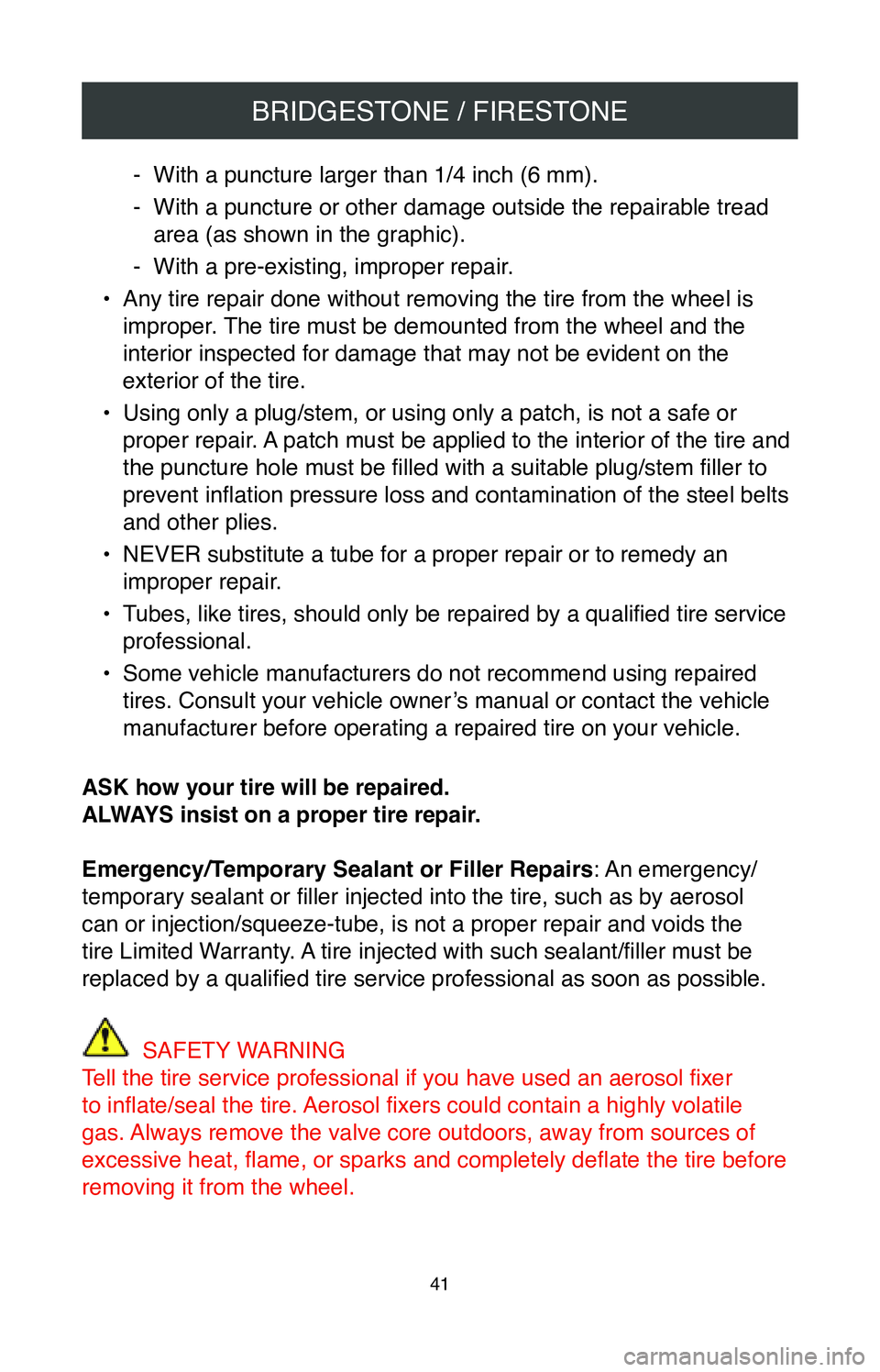
BRIDGESTONE / FIRESTONE
41
- With a puncture larger than 1/4 inch (6 mm).
-With a puncture or other damage outside the repairable tread
area (as shown in the graphic).
- With a pre-existing, improper repair.
•
Any tire repair done without removing the tire from the wheel is
improper. The tire must be demounted from the wheel and the
interior inspected for damage that may not be evident on the
exterior of the tire.
•
Using only a plug/stem, or using only a patch, is not a safe or
proper repair. A patch must be applied to the interior of the tire and
the puncture hole must be filled with a suitable plug/stem filler to
prevent inflation pressure loss and contamination of the steel belts
and other plies.
•
NEVER substitute a tube for a proper repair or to remedy an
improper repair.
•
Tubes, like tires, should only be repaired by a qualified tire service
professional.
•
Some vehicle manufacturers do not recommend using repaired
tires. Consult your vehicle owner’s manual or contact the vehicle
manufacturer before operating a repaired tire on your vehicle.
ASK how your tire will be repaired.
ALWAYS insist on a proper tire repair.
Emergency/Temporary Sealant or Filler Repairs: An emergency/
temporary sealant or filler injected into the tire, such as by aerosol
can or injection/squeeze-tube, is not a proper repair and voids the
tire Limited Warranty. A tire injected with such sealant/filler must be
replaced by a qualified tire service professional as soon as possible.
SAFETY WARNING
Tell the tire service professional if you have used an aerosol fixer
to inflate/seal the tire. Aerosol fixers could contain a highly volatile
gas. Always remove the valve core outdoors, away from sources of
excessive heat, flame, or sparks and completely deflate the tire before
removing it from the wheel.
Page 44 of 260
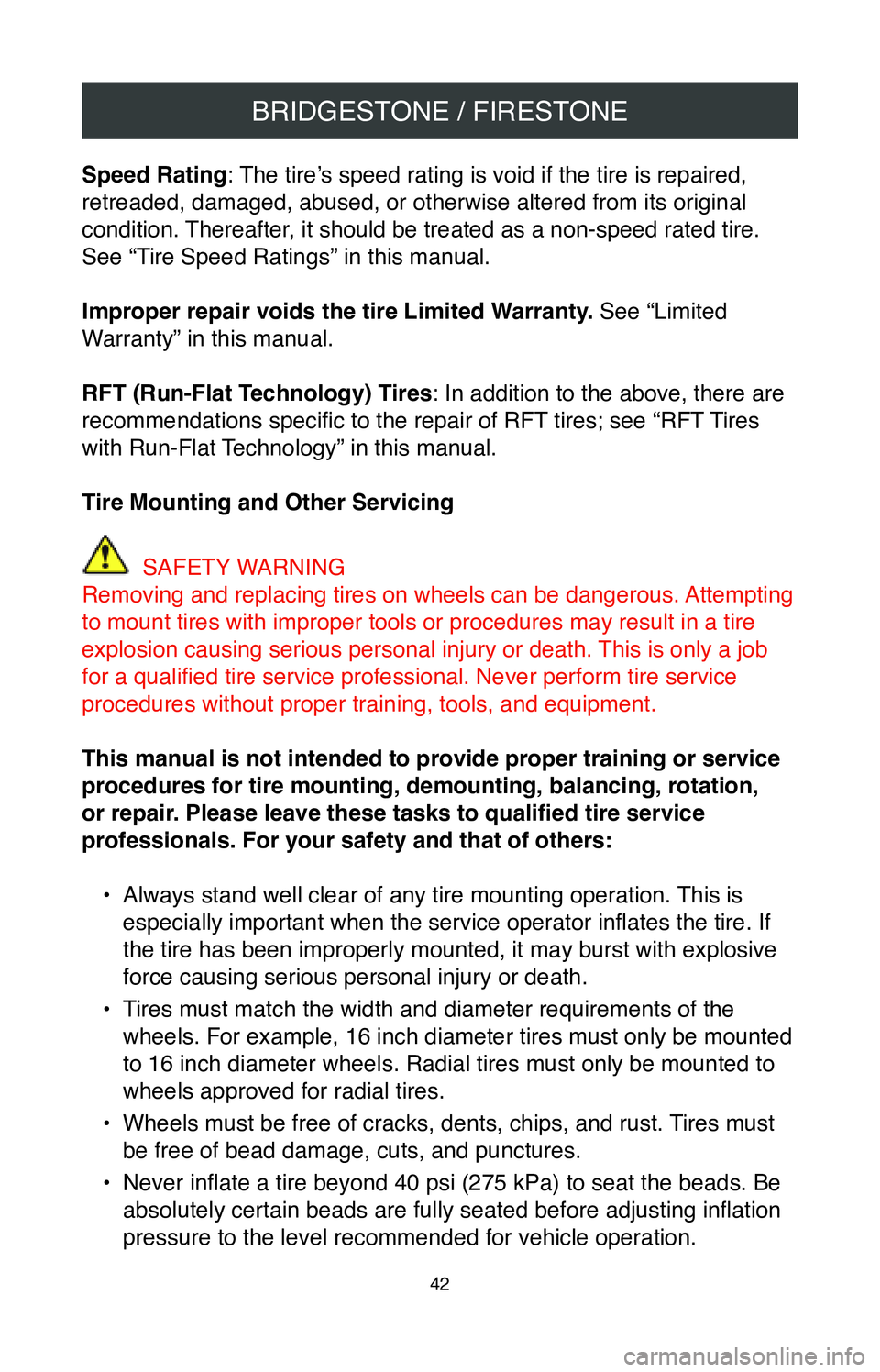
BRIDGESTONE / FIRESTONE
42
Speed Rating: The tire’s speed rating is void if the tire is repaired,
retreaded, damaged, abused, or otherwise altered from its original
condition. Thereafter, it should be treated as a non-speed rated tire.
See “Tire Speed Ratings” in this manual.
Improper repair voids the tire Limited Warranty. See “Limited
Warranty” in this manual.
RFT (Run-Flat Technology) Tires: In addition to the above, there are
recommendations specific to the repair of RFT tires; see “RFT Tires
with Run-Flat Technology” in this manual.
Tire Mounting and Other Servicing
SAFETY WARNING
Removing and replacing tires on wheels can be dangerous. Attempting
to mount tires with improper tools or procedures may result in a tire
explosion causing serious personal injury or death. This is only a job
for a qualified tire service professional. Never perform tire service
procedures without proper training, tools, and equipment.
This manual is not intended to provide proper training or service
procedures for tire mounting, demounting, balancing, rotation,
or repair. Please leave these tasks to qualified tire service
professionals. For your safety and that of others:
•
Always stand well clear of any tire mounting operation. This is
especially important when the service operator inflates the tire. If
the tire has been improperly mounted, it may burst with explosive
force causing serious personal injury or death.
•
Tires must match the width and diameter requirements of the
wheels. For example, 16 inch diameter tires must only be mounted
to 16 inch diameter wheels. Radial tires must only be mounted to
wheels approved for radial tires.
•
Wheels must be free of cracks, dents, chips, and rust. Tires must
be free of bead damage, cuts, and punctures.
•
Never inflate a tire beyond 40 psi (275 kPa) to seat the beads. Be
absolutely certain beads are fully seated before adjusting inflation
pressure to the level recommended for vehicle operation.
Page 45 of 260
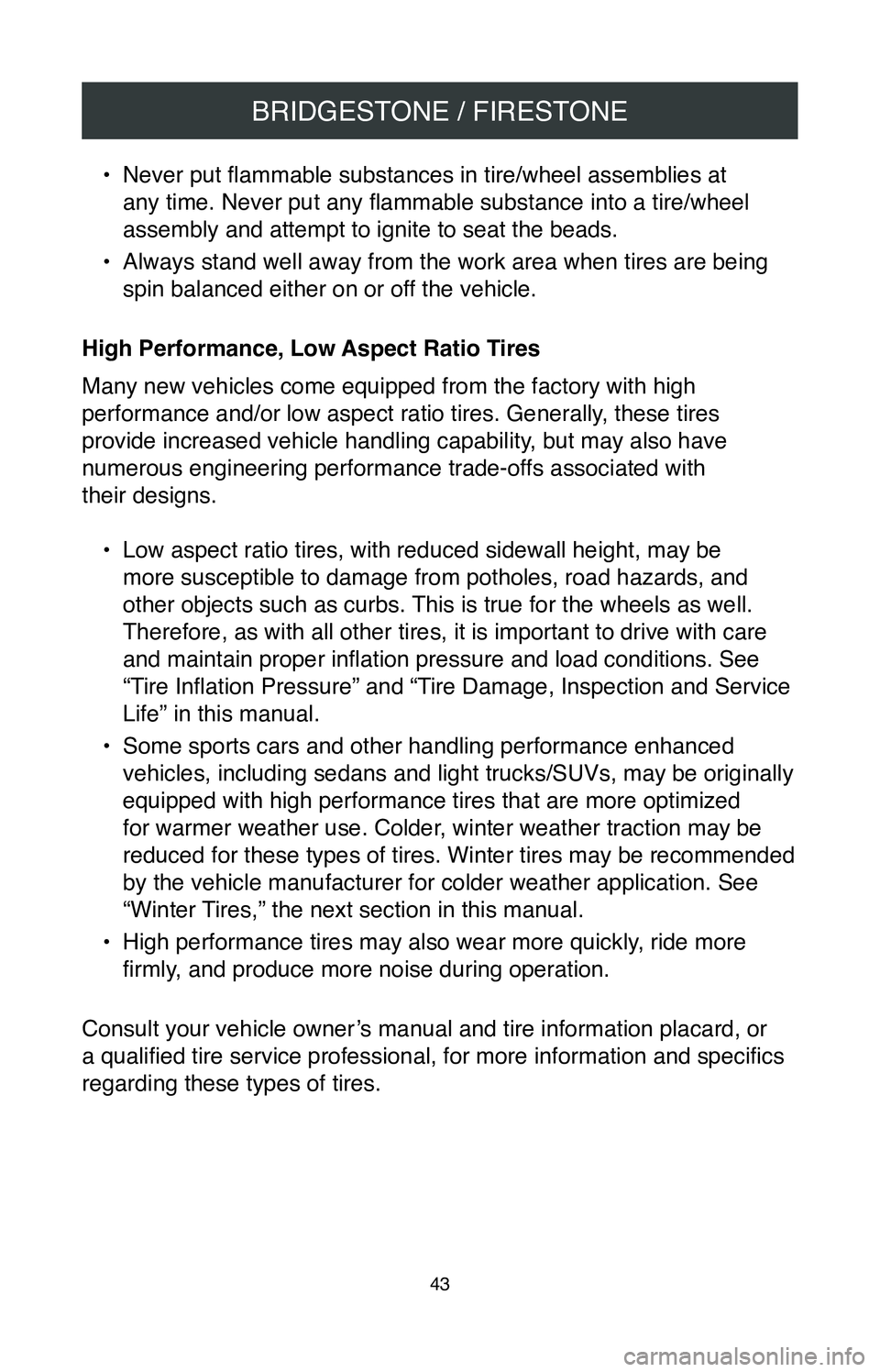
BRIDGESTONE / FIRESTONE
43
• Never put flammable substances in tire/wheel assemblies at
any time. Never put any flammable substance into a tire/wheel
assembly and attempt to ignite to seat the beads.
•
Always stand well away from the work area when tires are being
spin balanced either on or off the vehicle.
High Performance, Low Aspect Ratio Tires
Many new vehicles come equipped from the factory with high
performance and/or low aspect ratio tires. Generally, these tires
provide increased vehicle handling capability, but may also have
numerous engineering performance trade-offs associated with
their designs. •
Low aspect ratio tires, with reduced sidewall height, may be
more susceptible to damage from potholes, road hazards, and
other objects such as curbs. This is true for the wheels as well.
Therefore, as with all other tires, it is important to drive with care
and maintain proper inflation pressure and load conditions. See
“Tire Inflation Pressure” and “Tire Damage, Inspection and Service
Life” in this manual.
•
Some sports cars and other handling performance enhanced
vehicles, including sedans and light trucks/SUVs, may be originally
equipped with high performance tires that are more optimized
for warmer weather use. Colder, winter weather traction may be
reduced for these types of tires. Winter tires may be recommended
by the vehicle manufacturer for colder weather application. See
“Winter Tires,” the next section in this manual.
•
High performance tires may also wear more quickly, ride more
firmly, and produce more noise during operation.
Consult your vehicle owner’s manual and tire information placard, or
a qualified tire service professional, for more information and specifics
regarding these types of tires.
Page 48 of 260
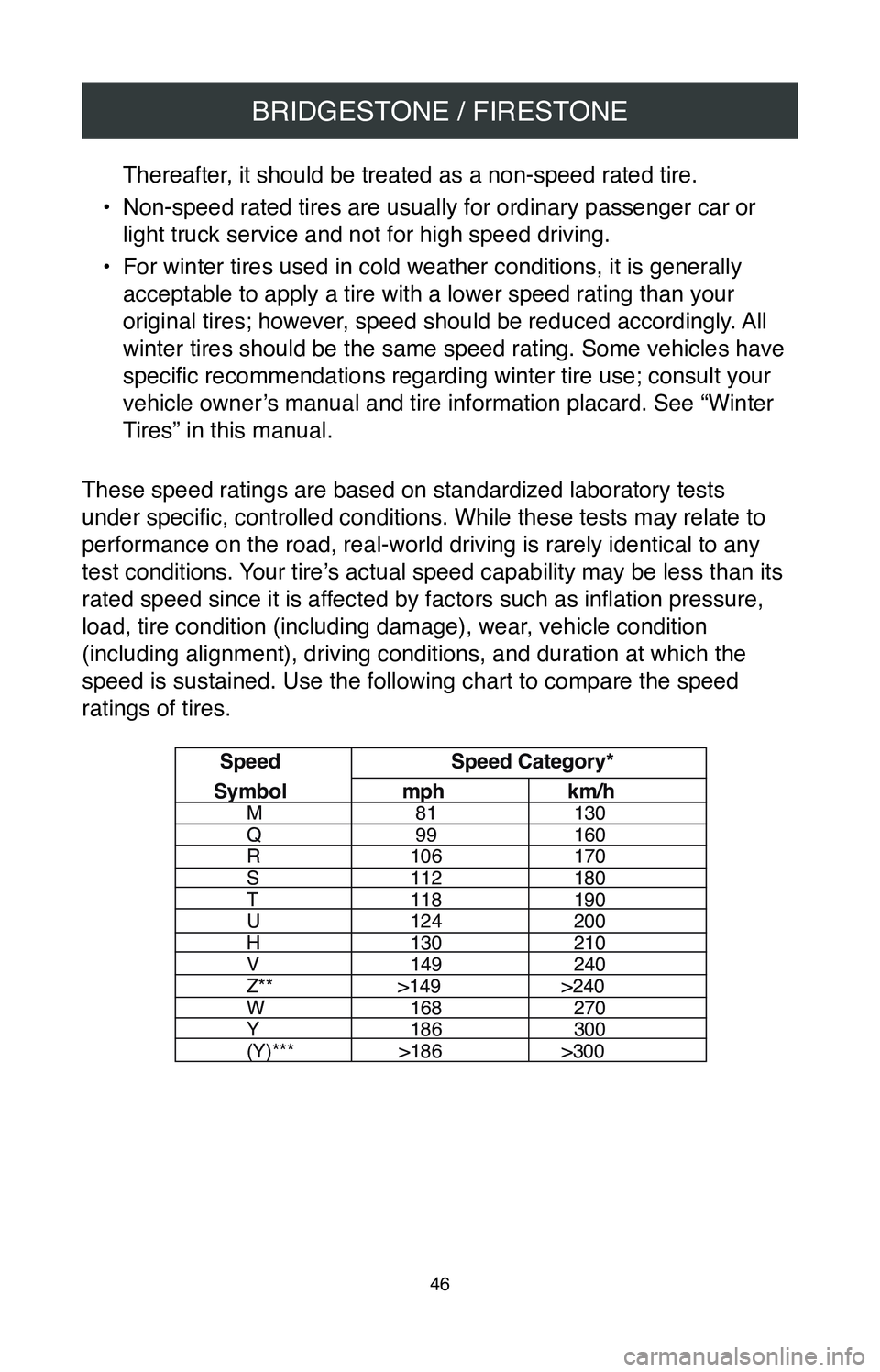
BRIDGESTONE / FIRESTONE
46
Thereafter, it should be treated as a non-speed rated tire.
•
Non-speed rated tires are usually for ordinary passenger car or
light truck service and not for high speed driving.
•
For winter tires used in cold weather conditions, it is generally
acceptable to apply a tire with a lower speed rating than your
original tires; however, speed should be reduced accordingly. All
winter tires should be the same speed rating. Some vehicles have
specific recommendations regarding winter tire use; consult your
vehicle owner’s manual and tire information placard. See “Winter
Tires” in this manual.
These speed ratings are based on standardized laboratory tests
under specific, controlled conditions. While these tests may relate to
performance on the road, real-world driving is rarely identical to any
test conditions. Your tire’s actual speed capability may be less than its
rated speed since it is affected by factors such as inflation pressure,
load, tire condition (including damage), wear, vehicle condition
(including alignment), driving conditions, and duration at which the
speed is sustained. Use the following chart to compare the speed
ratings of tires.
Speed Speed Category*
Symbol mph km/h
M81130
Q 99160
R 106170
S 112180
T 118190
U 124200
H 130210
V 149240
Z** >149 >240
W 168270
Y 186300
(Y)*** >186 >300
Page 49 of 260
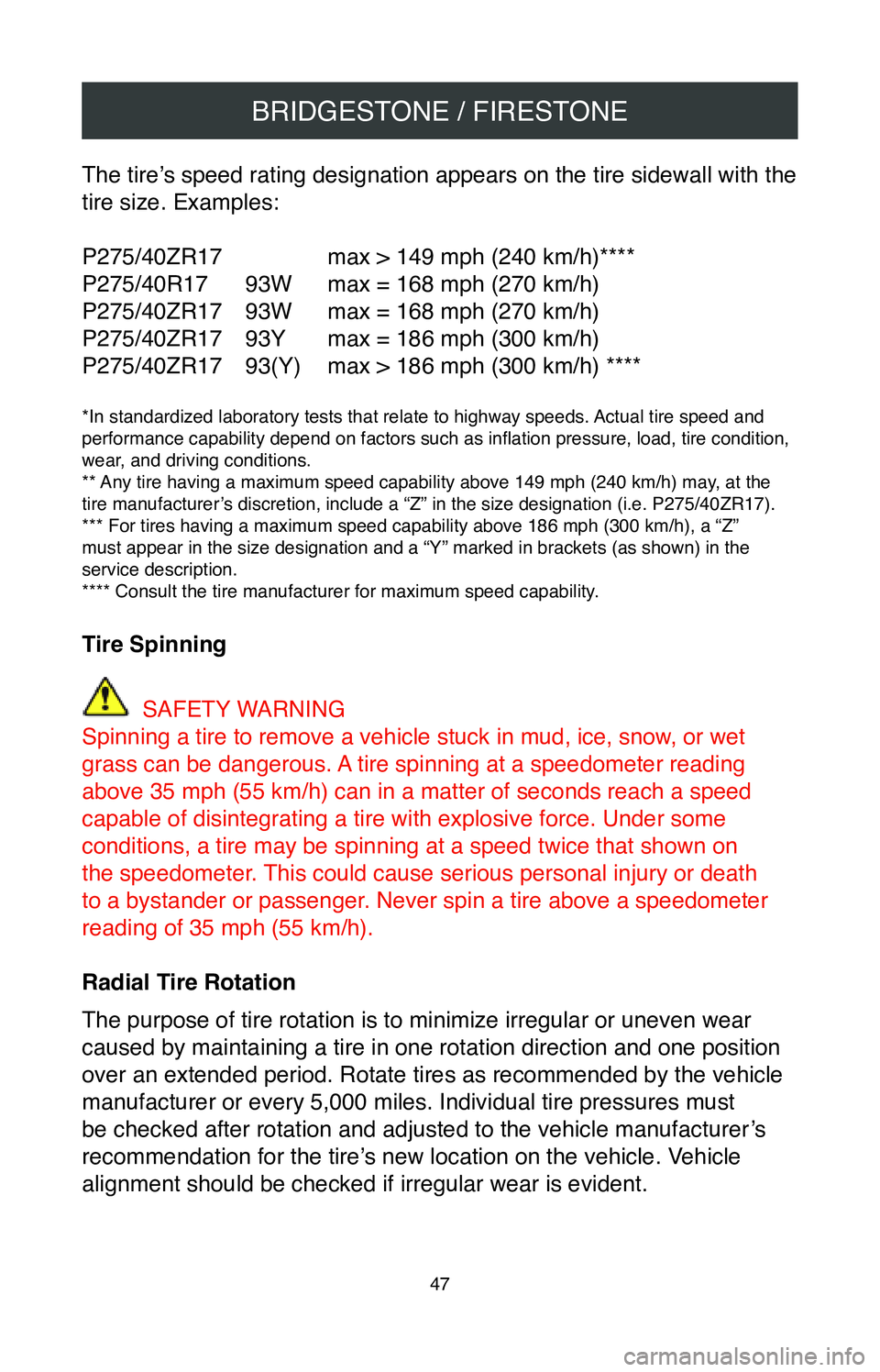
BRIDGESTONE / FIRESTONE
47
The tire’s speed rating designation appears on the tire sidewall with the
tire size. Examples:
P275/40ZR17
max > 149 mph (240 km/h)****
P275/40R17
93W max = 168 mph (270 km/h)
P275/40ZR17
93W max = 168 mph (270 km/h)
P275/40ZR17
93Y max = 186 mph (300 km/h)
P275/40ZR17
93(Y) max > 186 mph (300 km/h) ****
*In standardized laboratory tests that relate to highway speeds. Actual tire speed and
performance capability depend on factors such as inflation pressure, load, tire condition,
wear, and driving conditions.
** Any tire having a maximum speed capability above 149 mph (240 km/h) may, at the
tire manufacturer’s discretion, include a “Z” in the size designation (i.e. P275/40ZR17).
*** For tires having a maximum speed capability above 186 mph (300 km/h), a “Z”
must appear in the size designation and a “Y” marked in brackets (as shown) in the
service description.
**** Consult the tire manufacturer for maximum speed capability.
Tire Spinning
SAFETY WARNING
Spinning a tire to remove a vehicle stuck in mud, ice, snow, or wet
grass can be dangerous. A tire spinning at a speedometer reading
above 35 mph (55 km/h) can in a matter of seconds reach a speed
capable of disintegrating a tire with explosive force. Under some
conditions, a tire may be spinning at a speed twice that shown on
the speedometer. This could cause serious personal injury or death
to a bystander or passenger. Never spin a tire above a speedometer
reading of 35 mph (55 km/h).
Radial Tire Rotation
The purpose of tire rotation is to minimize irregular or uneven wear
caused by maintaining a tire in one rotation direction and one position \
over an extended period. Rotate tires as recommended by the vehicle
manufacturer or every 5,000 miles. Individual tire pressures must
be checked after rotation and adjusted to the vehicle manufacturer ’s
recommendation for the tire’s new location on the vehicle. Vehicle
alignment should be checked if irregular wear is evident.
Page 51 of 260
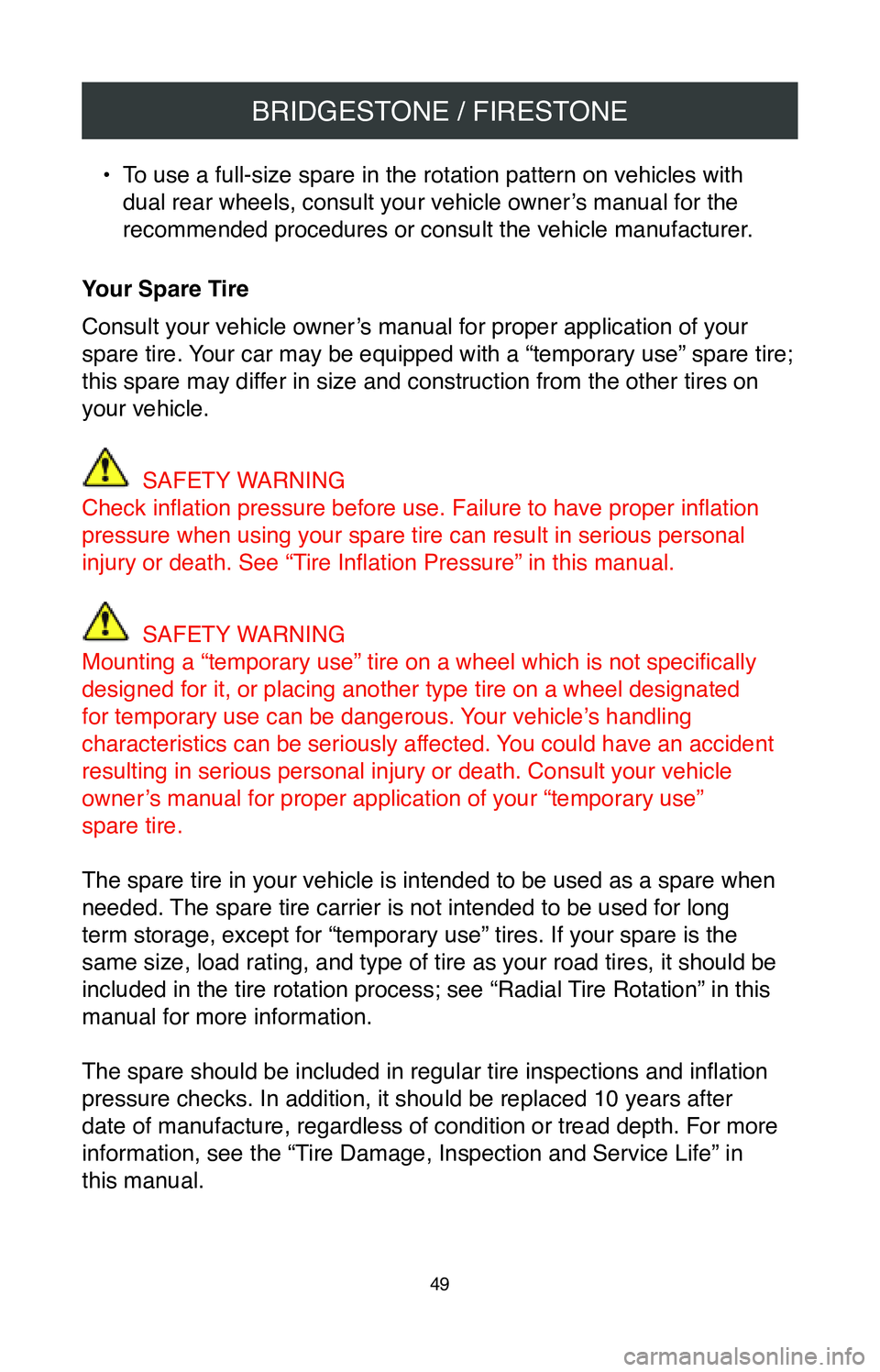
BRIDGESTONE / FIRESTONE
49
• To use a full-size spare in the rotation pattern on vehicles with
dual rear wheels, consult your vehicle owner’s manual for the
recommended procedures or consult the vehicle manufacturer.
Your Spare Tire
Consult your vehicle owner’s manual for proper application of your
spare tire. Your car may be equipped with a “temporary use” spare tire;
this spare may differ in size and construction from the other tires on
your vehicle.
SAFETY WARNING
Check inflation pressure before use. Failure to have proper inflation
pressure when using your spare tire can result in serious personal
injury or death. See “Tire Inflation Pressure” in this manual.
SAFETY WARNING
Mounting a “temporary use” tire on a wheel which is not specifically
designed for it, or placing another type tire on a wheel designated
for temporary use can be dangerous. Your vehicle’s handling
characteristics can be seriously affected. You could have an accident
resulting in serious personal injury or death. Consult your vehicle
owner’s manual for proper application of your “temporary use”
spare tire.
The spare tire in your vehicle is intended to be used as a spare when
needed. The spare tire carrier is not intended to be used for long
term storage, except for “temporary use” tires. If your spare is t\
he
same size, load rating, and type of tire as your road tires, it should b\
e
included in the tire rotation process; see “Radial Tire Rotation” in this
manual for more information.
The spare should be included in regular tire inspections and inflation
pressure checks. In addition, it should be replaced 10 years after
date of manufacture, regardless of condition or tread depth. For more
information, see the “Tire Damage, Inspection and Service Life” in
this manual.
Page 53 of 260
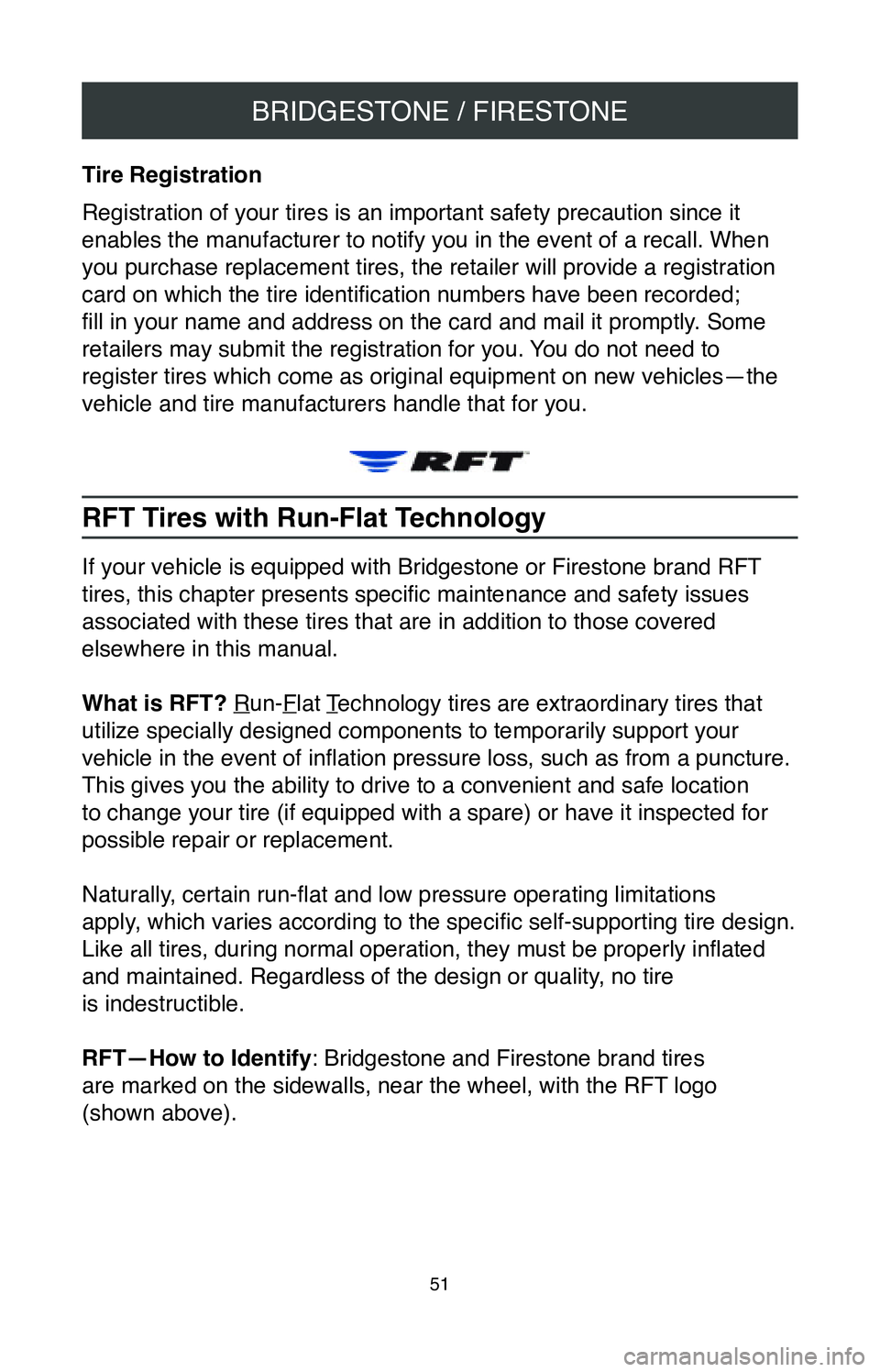
BRIDGESTONE / FIRESTONE
51
Tire Registration
Registration of your tires is an important safety precaution since it
enables the manufacturer to notify you in the event of a recall. When
you purchase replacement tires, the retailer will provide a registration\
card on which the tire identification numbers have been recorded;
fill in your name and address on the card and mail it promptly. Some
retailers may submit the registration for you. You do not need to
register tires which come as original equipment on new vehicles—the
vehicle and tire manufacturers handle that for you.
RFT Tires with Run-Flat Technology
If your vehicle is equipped with Bridgestone or Firestone brand RFT
tires, this chapter presents specific maintenance and safety issues
associated with these tires that are in addition to those covered
elsewhere in this manual.
What is RFT? Run-Flat Technology tires are extraordinary tires that
utilize specially designed components to temporarily support your
vehicle in the event of inflation pressure loss, such as from a puncture.
This gives you the ability to drive to a convenient and safe location
to change your tire (if equipped with a spare) or have it inspected for
possible repair or replacement.
Naturally, certain run-flat and low pressure operating limitations
apply, which varies according to the specific self-supporting tire design.
Like all tires, during normal operation, they must be properly inflated
and maintained. Regardless of the design or quality, no tire
is indestructible.
RFT—How to Identify : Bridgestone and Firestone brand tires
are marked on the sidewalls, near the wheel, with the RFT logo
(shown above).